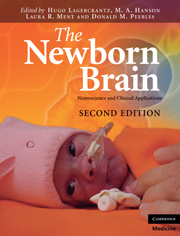Book contents
- Frontmatter
- Contents
- List of contributors
- Preface to the First Edition
- Preface to the Second Edition
- 1 Reflections on the origins of the human brain
- Section 1 Making of the brain
- Section 2 Sensory systems and behavior
- 9 Development of the somatosensory system
- 10 Principles of endogenous and sensory activity-dependent brain development: the visual system
- 11 Fetal and neonatal development of the auditory system
- 12 Newborn behavior and perception
- Section 3 Radiological and neurophysiological investigations
- Section 4 Clinical aspects
- Section 5 Follow-up
- Section 6 Consciousness
- Index
- Plate section
- References
9 - Development of the somatosensory system
from Section 2 - Sensory systems and behavior
Published online by Cambridge University Press: 01 March 2011
- Frontmatter
- Contents
- List of contributors
- Preface to the First Edition
- Preface to the Second Edition
- 1 Reflections on the origins of the human brain
- Section 1 Making of the brain
- Section 2 Sensory systems and behavior
- 9 Development of the somatosensory system
- 10 Principles of endogenous and sensory activity-dependent brain development: the visual system
- 11 Fetal and neonatal development of the auditory system
- 12 Newborn behavior and perception
- Section 3 Radiological and neurophysiological investigations
- Section 4 Clinical aspects
- Section 5 Follow-up
- Section 6 Consciousness
- Index
- Plate section
- References
Summary
Introduction
The somatosensory system deals with information from a variety of sensory receptors located in the skin, muscles, joints, and other deeper tissues. It enables us to experience touch, pain, warmth, and cold, and to sense the position and movements of our body. Understanding how this system develops structurally and functionally during embryonic and fetal life provides an insight into how the fetus and newborn infant develops the capacity to receive and experience sensations arising from noxious, tactile, thermal, or mechanical stimuli. Although it will be difficult to determine, unequivocally, when the fetus is first aware of its surroundings and conscious of perceiving these stimuli, we can at least define when the minimum structural and functional apparatus necessary to do so is present.
In this chapter we will first describe the structure of the main pathways that transmit tactile, thermal, nociceptive, and proprioceptive information from the periphery to the cerebral cortex via synaptic connections in the spinal cord or brainstem. We will then describe the structural, neurochemical, and functional development of the somatosensory system and the development of descending pathways from the brainstem which modify this activity. We will speculate on whether activity in the fetal somatosensory pathways is a necessary requirement for the appropriate development of these pathways as it appears to be for the visual system (Goodman & Shatz, 1993; Penn & Shatz, 1999). Clearly, very little experimentation can be performed on the human fetus, and laboratory animals are therefore used to answer these questions.
- Type
- Chapter
- Information
- The Newborn BrainNeuroscience and Clinical Applications, pp. 129 - 146Publisher: Cambridge University PressPrint publication year: 2010
References
- 4
- Cited by

